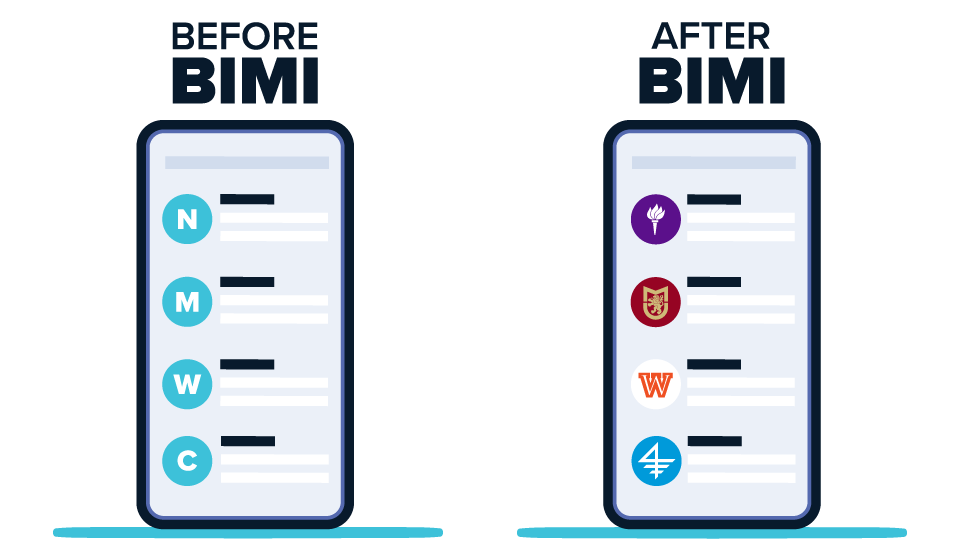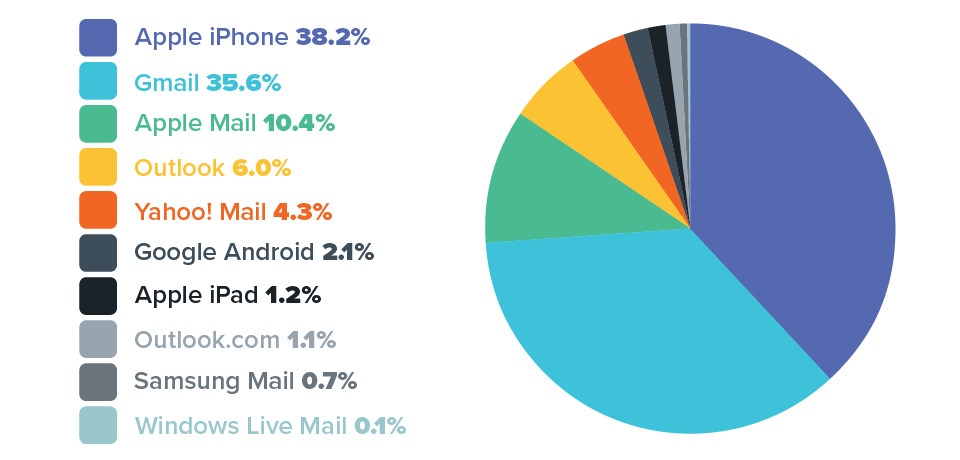Despite how it sounds, BIMI (pronounced: bih-mee), is not another type of cryptocurrency, another Gen Z acronym, or the name of a celebrity’s newborn.
It’s Brand Indicators for Message Identification (obviously!), or BIMI for short. It’s a way for brands to stand out in the email inbox with their logo, ultimately increasing visibility, engagement, and trust with their recipients. Recently, more and more Email Service Providers (ESPs), like Gmail, Yahoo Mail, AOL, etc., are starting to support BIMI. In fact, as of late October 2022, Apple Mail is supporting BIMI with the recent updates for iOS 16 and macOS Ventura.
At Spark451, we believe now is the time for colleges and universities to consider using BIMI to make an even stronger impression on students via their email marketing efforts. Read on for more details on how BIMI works and why it’s right for higher ed. We’ll even tell you how to set it up!
What is BIMI?
In layman’s terms (we’re not getting technical yet), BIMI allows brands to show their logos in the inbox next to their messages.

Interestingly, BIMI was not necessarily created with marketing in mind, but moreso to make the email industry more secure. In a world where email scams and phishing are more prevalent than ever, there are specific email sending authentications needed in order for BIMI to work. (More on those specifications later.)
Think about it: If someone knocks on your door claiming to be Ed Sheeran and offering you free concert tickets without showing his face, would you trust them and open the door? I would hope not — that sounds sketchy! But if he shows his face and it is actually THE Ed Sheeran, you would most likely open the door! Admittedly, opening college marketing emails isn’t as exciting as opening your door to Ed Sheeran, but you get the point. There’s more trust when you see a face, or logo.
Why is this a BIG DEAL for higher ed?
Initially, BIMI was only supported by a few ESPs, but now that Gmail announced their support of BIMI in July 2021, and now that Apple Mail is also on board, BIMI is officially a big deal for us as college marketers. Those ESPs represent a significant portion of our prospective student audience, at roughly 75–85%. Gen Z is a very visual bunch (looking at you, TikTok) and BIMI provides an opportunity to catch their attention in their already-flooded-with-college-marketing inboxes. Jumping on the BIMI train will be vital to the success of your email marketing campaigns.

Other benefits to implementing BIMI?
I. Increased Open Rates
Based on the Yahoo Mail BIMI beta program, open rates increased by an average of 10% for emails using BIMI. Some studies even found that brand competitors that did not use BIMI showed a decrease in open rate, and that customer purchasing decisions were negatively impacted. This is your chance to stand out among competitor schools in the inbox — especially right now, while most schools don’t have BIMI.
II. Improved Email Deliverability (Inbox Placement)
Besides the obvious benefit of standing out in the inbox and attracting more opens, BIMI indirectly improves email deliverability, or inbox placement. By implementing BIMI, ESPs will see the increase in email engagement, proving that you’re sending legitimate and relevant messaging, AND that you’ve set the highest level of security to protect their users from phishing scams. Ultimately, the job of ESPs is to keep their users (our recipients) happy and safe. In turn, ESPs reward us by keeping our messages out of the spam folder and by giving us the privilege of showing our logos in the inbox: ✨BIMI✨
How is BIMI implemented?
A few requirements need to be met in order to implement BIMI into your email marketing. You’ll most likely require assistance from your IT/web team.
Step 1: Ensure email sending authentications are set up properly, specifically the DMARC policy
To send emails legitimately and not be classified as a spammer, there are specific sending authentications that must be aligned in your DNS records: Sender Policy Framework (SPF) and DomainKeys Identified Mail (DKIM). Something that makes BIMI a little more complicated to obtain is setting the proper Domain-based Message Authentication, Reporting, and Conformance (DMARC) record, or DMARC policy.
There are 3 types of DMARC policies: None, Quarantine, and Reject. Each can be thought of as a security level — with a policy of Reject being the highest — and ultimately protects your domain from being spoofed. Should a spammer impersonate your domain and send on your behalf, the DMARC policy would route their emails to spam (if the policy is set to Quarantine), or block their emails completely (if the policy is set to Reject). BIMI will only work if there is a secure DMARC policy in place, either Quarantine or Reject.
Step 2: Provide logo in a secure format with specific parameters
BIMI requires that a logo be in Scalable Vector Graphics (SVG) format to provide the highest quality image in the inbox for all devices. Overall, logos must be centered, have a solid background, a square aspect ratio, and be under 32 kilobytes. The logo must also be hosted on a publicly accessible server. This is how the BIMI record will “call in” and render the logo into the recipient’s inbox. Here is a detailed list of the BIMI logo specifications.
Step 3: Obtain a VMC
Step 4: Publish the BIMI record in your DNS
After you’ve jumped through the above hoops, the BIMI record can be added into the DNS. There are various tools that can help generate the BIMI record and confirm that it’s set up properly, like the BIMI LookUp & Generator. It can take anywhere from 24 hours to up to a few weeks for the logo to start appearing in the inbox.
Of course, BIMI is just the tip of the iceberg when it comes to delivering impactful email marketing campaigns for higher ed. Spark451’s email marketing experts and strategists can help you through everything from the technical aspects of implementing BIMI for your institution, to planning, crafting, and delivering robust, highly personalized campaigns that will support your enrollment goals. Feel free to reach out whenever you’re ready to talk.